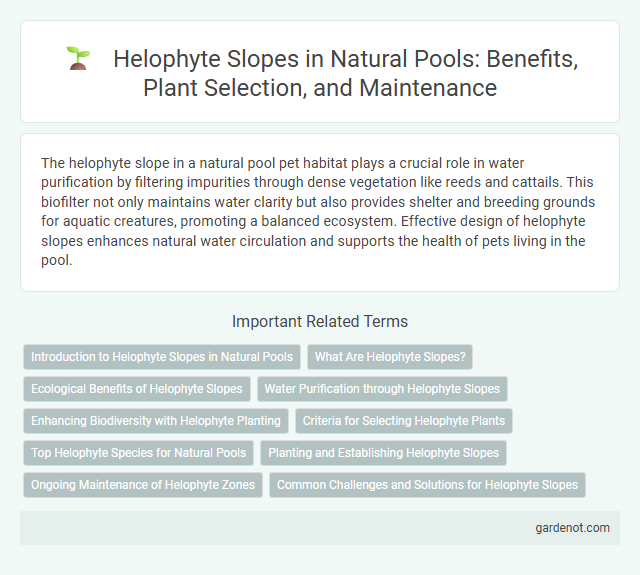The helophyte slope in a natural pool pet habitat plays a crucial role in water purification by filtering impurities through dense vegetation like reeds and cattails. This biofilter not only maintains water clarity but also provides shelter and breeding grounds for aquatic creatures, promoting a balanced ecosystem. Effective design of helophyte slopes enhances natural water circulation and supports the health of pets living in the pool.
Introduction to Helophyte Slopes in Natural Pools
Helophyte slopes in natural pools serve as essential biofilters, using emergent plants to enhance water purification through nutrient uptake and microbial activity. This zone supports a diverse range of helophyte species like cattails and reeds, which promote sediment stabilization and provide habitat for beneficial microorganisms. The integration of helophyte slopes contributes significantly to maintaining water clarity and ecological balance in natural swimming pools.
What Are Helophyte Slopes?
Helophyte slopes are integral components of natural pools, designed to support aquatic plants that thrive in shallow water and saturated soil environments. These vegetated slopes act as biological filters, enhancing water quality by trapping sediments and absorbing nutrients through plant roots. The presence of helophyte slopes encourages biodiversity and contributes to the ecological balance within natural swimming ecosystems.
Ecological Benefits of Helophyte Slopes
Helophyte slopes enhance natural pool ecosystems by efficiently filtering pollutants and improving water quality through nutrient absorption and sediment stabilization. These planted zones support biodiversity by providing habitat for aquatic and terrestrial species, promoting a balanced and resilient ecosystem. Their root systems reduce erosion and enhance oxygenation, which sustains healthy microbial activity essential for natural pool self-purification.
Water Purification through Helophyte Slopes
Helophyte slopes play a crucial role in natural pool water purification by utilizing aquatic plants such as reeds and rushes to filter contaminants and absorb excess nutrients. Their dense root systems promote microbial activity that breaks down pollutants, enhancing water clarity and quality. This biological filtration method reduces reliance on chemical treatments, supporting sustainable and eco-friendly pool maintenance.
Enhancing Biodiversity with Helophyte Planting
Helophyte slopes in natural pools serve as critical biofilters, enhancing water quality and providing diverse habitats for aquatic and terrestrial species. Planting native helophyte species like reeds, sedges, and rushes increases biodiversity by supporting pollinators and offering shelter for amphibians and invertebrates. These vegetation zones also stabilize soil erosion, improve nutrient cycling, and sustain ecological balance within the aquatic ecosystem.
Criteria for Selecting Helophyte Plants
Helophyte slopes in natural pools require plants with strong root systems to stabilize the substrate and effectively filter water contaminants. Selecting helophyte species involves prioritizing native plants adapted to local climate conditions, high oxygenation ability, and tolerance to fluctuating water levels. Plants such as cattails (Typha), reedmace (Schoenoplectus), and bulrushes (Scirpus) meet these criteria by promoting biodiversity and enhancing water purification.
Top Helophyte Species for Natural Pools
Top helophyte species for natural pools include common reed (Phragmites australis), bulrush (Schoenoplectus spp.), and cattail (Typha latifolia), which excel in nutrient absorption and water filtration. These emergent plants stabilize the helophyte slope, enhancing biodiversity by providing habitat for aquatic fauna. Their extensive root systems improve sediment retention and support natural pool health through effective pollutant removal.
Planting and Establishing Helophyte Slopes
Establishing helophyte slopes in natural pools involves selecting native, water-tolerant plants such as cattails, reeds, and sedges that efficiently filter nutrients and provide habitat for aquatic life. Planting should occur during spring or early summer in nutrient-rich, well-drained soils to encourage root development and stabilization of the slope. Regular monitoring and maintenance during the first two years ensure successful plant establishment and long-term ecosystem balance.
Ongoing Maintenance of Helophyte Zones
Ongoing maintenance of helophyte zones in natural pools involves regular removal of dead plant material to prevent nutrient buildup and ensure optimal water clarity. Monitoring plant growth and health helps sustain effective filtration and supports biodiversity within the helophyte slope. Seasonal pruning and debris management maintain the balance between natural aesthetics and functional water purification.
Common Challenges and Solutions for Helophyte Slopes
Helophyte slopes in natural pools often face challenges such as uneven plant growth, sediment accumulation, and water stagnation, leading to reduced filtration efficiency. Implementing regular maintenance practices like strategic planting to enhance root density, controlled sediment removal, and ensuring adequate water flow can effectively address these issues. Utilizing native helophyte species adapted to local conditions also promotes resilience and long-term slope stability.
Helophyte slope Infographic

 gardenot.com
gardenot.com